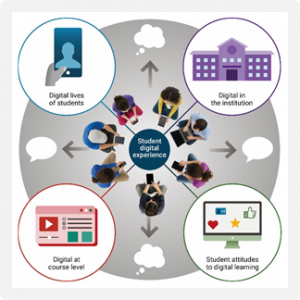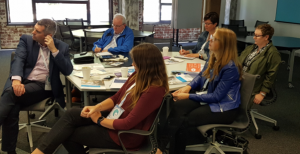Posted on behalf of Ruth Drysdale (senior co-design manager, Jisc)

I was delighted to co-facilitate a workshop with Fiona Salisbury (Deputy Director, Learning and Engagement in the Library) from La Trobe University Melbourne on 28th Nov 2018, examining the digital experience insights (formerly known as the tracker) findings from 12 Australia and New Zealand (ANZ) pilot universities that gathered over 21,000 students’ responses. You can download the full report here: Digital experience insights survey 2018: findings from Australian and New Zealand university students
When that many students give feedback, you’ve got to listen!
The digital experience insights survey covers these 4 key areas:
Seeing the Universities’ digital environment through the eyes of staff and students
Why is it important for us to know how students are using technology? Universities’ make large investments in digital environment as well as the physical campus, but how is the digital environment evaluated to ensure it enhances the overall student experience?
With the emergence of initiatives like the Intelligent Campus and learner analytics, we need to ensure that students and staff are aware of, and engaged with the Universities ‘digital environment. This is in part, so they understand and consent to how data about them could be captured and used. Universities are therefore increasingly working in partnership with students when developing the digital learning environment, so it better meets their needs and offers them the digital skills for the modern workplace. Understanding how students use technology and their attitudes towards its use in learning, is a good place to start.
But do we really know how students are using technology to support their learning?
While the commitment to engage students in the development of their digital environment is impressive, there is less evidence that these engagements are informed by local evidence. Work done by Jisc’s Digital Student project in 2014-16 highlighted that consultations with students were often poorly designed, and that national surveys did not provide a coherent or detailed enough picture of the student digital experience either. The Jisc digital experience student survey was developed in response to this need.
In 2018, 83 UK institutions took part in our third digital experience student survey, gathering more than 37,000 responses. 12 Australian and New Zealand Universities also collected 21,095 student responses, throwing up some interesting comparisons. Last year Jisc also piloted a complimentary teaching staff survey that offers insights into their attitudes about their digital teaching environment.
These student and teaching staff research-based questions provide actionable evidence locally and support meaningful comparisons within and across organisations to impact their digital strategies.
At Jisc we strongly believe that understanding the digital needs, experiences and expectations of learners and staff will help underpin an organisation’s plans and priorities.
Finding out what students and staff think about their digital environment can be challenging. Without a clear process for engaging people in conversation about digital infrastructure and practices, it is difficult to tell whether an organisation’s investment is delivering the learning and teaching experiences expected.
Jisc’s digital experience insights service provides survey tools that enable organisations to collect and analyse data about the digital environment and how digital technologies are used in learning and teaching. It allows organisations to:
- Gather evidence from learners and now staff about their digital experience benchmark with peers and compare your data over time
- Make better informed decisions about the digital environment
- Target resources for improving digital provision
- Plan other research, data gathering and student engagement around digital issues
- Deliver targeted continuous professional development (CPD) for staff
- Demonstrate quality enhancement and student engagement to external bodies and to students themselves
The findings from the surveys support organisations in making evidence-based decisions and in driving transformational change. Understanding the digital needs, experiences and expectations of staff and learners will help underpin an organisation’s plans.
You can see your university’s digital environment through the eyes of your staff and students by watching this short animation to find more about the digital experience insights service.
At the workshop we heard project leads from participating 2018 ANZ pilot universities explain how the process helped them to engage their students, make better-informed decisions, and enhance their digital strategies. Here are the links to their presentations;
- Ruth Drysdale, senior co-design manager, Jisc gave the background to the tracker survey followed by Fiona Salisbury who introduced the purpose of the 2018 ANZ pilot. View Ruth’s presentation
- Dr Sam McKenzie, teaching and learning project manager ,Institute for Teaching and Learning Innovation at the University of Queensland. See also their case study. View Sam’s presentation.
- Fiona Salisbury, deputy director learning and engagement, La Trobe University, View Fiona’s presentation
- Sue Atkinson Adelaide University. View Sue’s presentation
- Heather Lamond, associate university librarian, client services, Massey University, New Zealand. View Heather’s presentation
- Prof Steven Warburton, assistant vice-chancellor (digital futures), Victoria University of Wellington, New Zealand. View Steven’s presentation
Contact Help@jisc.ac.uk using digital insights in the subject line if you would like to know more about the survey instrument.
You can find resources for staff and student engagement on the advice and guidance section of our website.
After these case studies we heard the eagerly awaited overall ANZ results from Helen Beetham, who very kindly woke up in the early hours to present the key findings from the 2018 Tracker ANZ pilot. Here are some snippets from Helen’s excellent presentation:
Theme 1: the digital lives of learners
 Eight out of ten students agreed that their university supports them to use their own digital devices (much higher than in the UK). But only around half said their university helps them stay safe online, gives them access to online health and wellbeing services, or keeps their data secure. Students are most likely to look to their peers first for support with digital issues.
Eight out of ten students agreed that their university supports them to use their own digital devices (much higher than in the UK). But only around half said their university helps them stay safe online, gives them access to online health and wellbeing services, or keeps their data secure. Students are most likely to look to their peers first for support with digital issues.
Theme 2: digital in the institution
 Power points for charging laptops, reliable wifi and high-quality lecture recording are top of students’ recommendations for improvement.
Power points for charging laptops, reliable wifi and high-quality lecture recording are top of students’ recommendations for improvement.
Theme 3: digital at course level
 Students in ANZ are more positive about their learner management system (LMS) experience than students in the UK.
Students in ANZ are more positive about their learner management system (LMS) experience than students in the UK.
Almost 60% agreed that their local LMS is well designed and almost half want it to be used more by teaching staff. Students were least positive about the collaborative features of their LMS. The median response to this statement was neutral.
Theme 4: student attitudes to digital, key messages from the free text data
 Independence and organisation
Independence and organisation
Independence, flexibility and being able to organise their study time are benefits that students have come to rely on from digital learning. Distance students particularly value them.
Value for money
Students expect value for money, whether on campus or at a distance. A lack of interaction with teaching staff, and poor access to computers and printing, are reasons they can feel let down.
The digitally disenchanted
Address the anxieties of some students who find digital a distraction, or lack confidence in their skills, or worry about losing face-to-face contact with lecturers and peers.
The attendance paradox
Recorded lectures and online activities need to be engaging for everyone – but the face-to-face experience should give on-campus students a good reason for turning up.
Invest in the technologies students value
Subject-specialist applications such as data analysis and design, and up-to-date tools for
the digital workplace, especially if they can access them on their own laptops
Key similarities and differences ANZ and UK students
- Student responses are extremely similar across the national sectors
- These similarities help us to validate the survey instrument as reflecting a real construct (the ‘student digital experience’) made up of several consistent factors
- ‘Developing digital skills’ is the key factor influencing the overall digital experience of students in both ANZ and UK
- Significant differences may be explained by the different contexts, e.g. ANZ students are more likely to be studying at a distance: these would need to be explored further
The full ANZ Student report, along with the UK Student and UK Staff reports are published on the reports page of our website.
Get in touch
Get in touch by emailing Ruth.Drysdale@Jisc.ac.uk if you would like to take part in the follow on 2019 ANZ pilot, to hear from your staff as well as students about their digital experiences.




